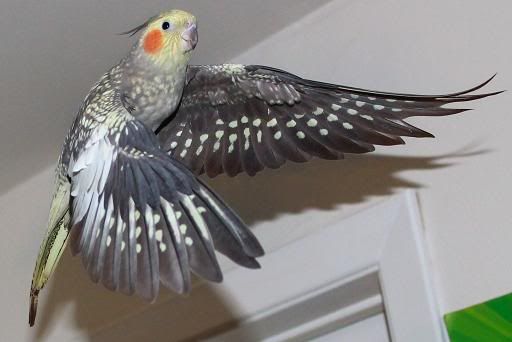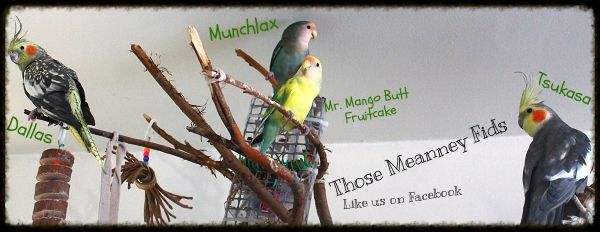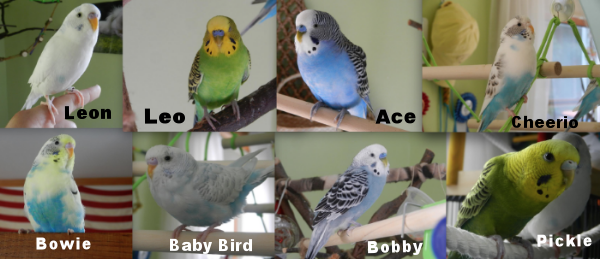Post by Casey on Aug 2, 2012 21:39:24 GMT -8
Teaching A Bird To Fly

Many people get a bird already clipped, and often this bird is clipped before it fledged, meaning before it learned how to fly. This is a common practice unfortunately and often creates problems for the bird.
A bird that was clipped before it fledges often tries to fly but ends up falling backwards or spiraling to the floor and can crash land. The bird will often have a lack of confidence and will be very clumsy. Many birds will also lack the muscle development that flighted birds have and can often become emotionally insecure.
What can you do to help this situation?
Step One: The bird must grow the flights back. When the bird starts to molt them back in, do not clip the bird and allow the flights to grow back in. The bird may start flapping on its own at this point, but if not you can have the bird sit on your finger and gently drop and raise your hand, making the bird flap. Do not do this rough enough that the bird falls off or seems scared, take it slow and stop if the bird shows signs of being tired. These include panting and wings drooping. Stop the exercise and let the bird rest in his or her cage for the time and allow them some water.
Step Two: The bird should have most of its flights before this is attempted. Pull blinds down over the windows and close the door to the flight training room. Place a blanket around the area you are working in case the bird falls. This will create a soft spot for the bird should he or she crashes. Turn ceiling fans completely off and be sure the room is safe. You will need spray millet or a very much loved treat.
Step Three: Now that the bird's area is safe from accidents as much as possible, it's time to start the training. Hold the bird on your hand. Place the treat of your bird's choice on the "target". It is easier to start off with a bed or wide flat surface. Show your bird the treat. Have the bird hop off your hand to the target. If they land safely, allow them to have the treat. A hop should include one flap, but if this is still too much for your bird, simply have the bird hop down. This will show the bird what it needs to do.
Step Four: Once the bird grasps the idea, take a step back. The bird should try to flap to the target. If they land successfully on the bed/target let them have the treat. If they do not land successfully, move back to step three. Once the bird can successfully land on the target you may move farther back. Should the bird miss a step, you will need to go back to the step before. This step teaches the bird how to fly forward and practice some proper landing, but the landing is still on a very wide surface.
Step Five: Eventually your bird should be able to land on the target from as far away as possible. Once your bird is able to do this, you can move to different locations to make your bird have to turn in flight to get to the target. This will improve the maneuverability in flight. Try many different areas so the bird has much practice.
Step Six: Once your tiel can land every which way onto the wide target, you can start using narrower targets such as a perch or playgym or cage top if you had not been using that before. These will help teach your bird how to land on different diameters and will be the final step in teaching your bird how to fly.
I myself have used this method with my own bird Dally as she was clipped before she fledged and she often injured herself falling backwards. Using this method, she became our best and most accurate flier.

Many people get a bird already clipped, and often this bird is clipped before it fledged, meaning before it learned how to fly. This is a common practice unfortunately and often creates problems for the bird.
A bird that was clipped before it fledges often tries to fly but ends up falling backwards or spiraling to the floor and can crash land. The bird will often have a lack of confidence and will be very clumsy. Many birds will also lack the muscle development that flighted birds have and can often become emotionally insecure.
What can you do to help this situation?
Step One: The bird must grow the flights back. When the bird starts to molt them back in, do not clip the bird and allow the flights to grow back in. The bird may start flapping on its own at this point, but if not you can have the bird sit on your finger and gently drop and raise your hand, making the bird flap. Do not do this rough enough that the bird falls off or seems scared, take it slow and stop if the bird shows signs of being tired. These include panting and wings drooping. Stop the exercise and let the bird rest in his or her cage for the time and allow them some water.
Step Two: The bird should have most of its flights before this is attempted. Pull blinds down over the windows and close the door to the flight training room. Place a blanket around the area you are working in case the bird falls. This will create a soft spot for the bird should he or she crashes. Turn ceiling fans completely off and be sure the room is safe. You will need spray millet or a very much loved treat.
Step Three: Now that the bird's area is safe from accidents as much as possible, it's time to start the training. Hold the bird on your hand. Place the treat of your bird's choice on the "target". It is easier to start off with a bed or wide flat surface. Show your bird the treat. Have the bird hop off your hand to the target. If they land safely, allow them to have the treat. A hop should include one flap, but if this is still too much for your bird, simply have the bird hop down. This will show the bird what it needs to do.
Step Four: Once the bird grasps the idea, take a step back. The bird should try to flap to the target. If they land successfully on the bed/target let them have the treat. If they do not land successfully, move back to step three. Once the bird can successfully land on the target you may move farther back. Should the bird miss a step, you will need to go back to the step before. This step teaches the bird how to fly forward and practice some proper landing, but the landing is still on a very wide surface.
Step Five: Eventually your bird should be able to land on the target from as far away as possible. Once your bird is able to do this, you can move to different locations to make your bird have to turn in flight to get to the target. This will improve the maneuverability in flight. Try many different areas so the bird has much practice.
Step Six: Once your tiel can land every which way onto the wide target, you can start using narrower targets such as a perch or playgym or cage top if you had not been using that before. These will help teach your bird how to land on different diameters and will be the final step in teaching your bird how to fly.
I myself have used this method with my own bird Dally as she was clipped before she fledged and she often injured herself falling backwards. Using this method, she became our best and most accurate flier.



